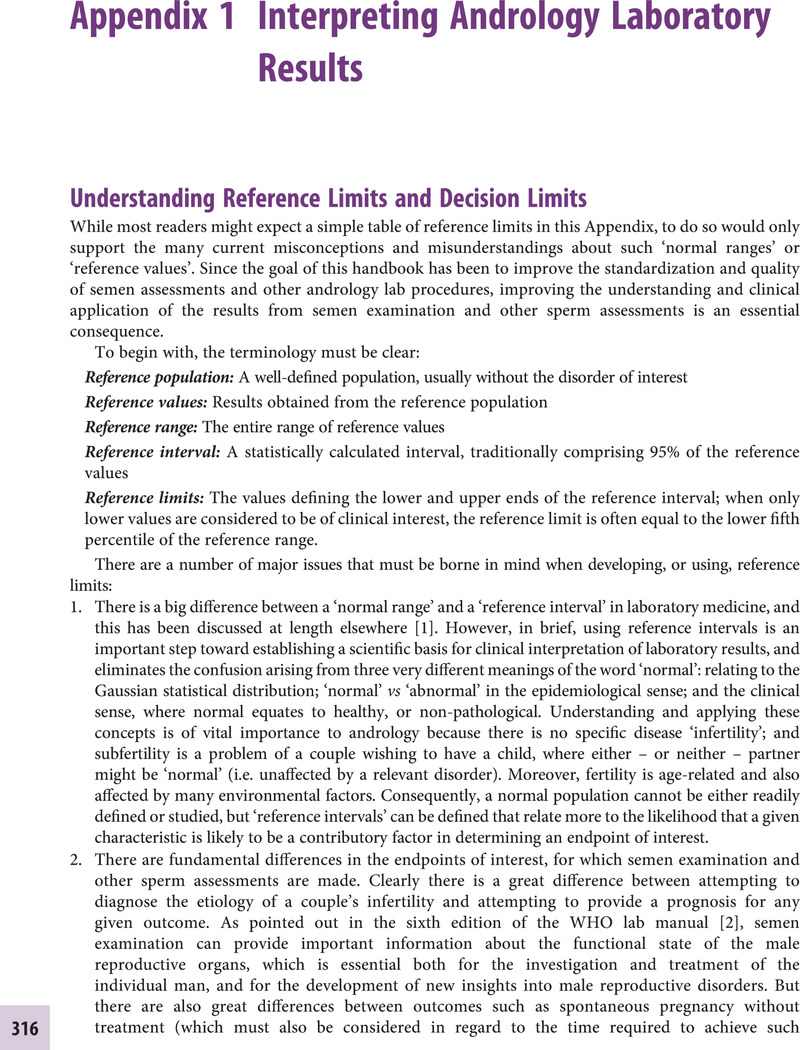Book contents
- A Practical Guide to Basic Laboratory Andrology
- A Practical Guide to Basic Laboratory Andrology
- Copyright page
- Contents
- Abbreviations
- Chapter 1 Introduction
- Chapter 2 Basic Physiology
- Chapter 3 Basic Semen Examination
- Chapter 4 Extended Semen Analysis
- Chapter 5 Sperm DNA
- Chapter 6 Computer-Aided Sperm Analysis
- Chapter 7 Sperm Function Tests
- Chapter 8 Tests of Sperm-Cervical Mucus Interaction
- Chapter 9 Sperm Preparation
- Chapter 10 Sperm Cryopreservation
- Chapter 11 Preparation of Surgically Retrieved Spermatozoa
- Chapter 12 Quality Management and Accreditation
- Chapter 13 Risk Management
- Chapter 14 Reproductive Toxicology
- Chapter 15 Andrology Laboratory Safety
- Book part
- Appendix 1 Interpreting Andrology Laboratory Results
- Appendix 2 Equipment Required for a Basic Andrology Laboratory
- Appendix 3 Home Testing
- Appendix 4 Example Andrology Laboratory Forms
- Appendix 5 Comparison of Replicate Counts
- Index
- References
Appendix 1 - Interpreting Andrology Laboratory Results
Published online by Cambridge University Press: 16 February 2022
- A Practical Guide to Basic Laboratory Andrology
- A Practical Guide to Basic Laboratory Andrology
- Copyright page
- Contents
- Abbreviations
- Chapter 1 Introduction
- Chapter 2 Basic Physiology
- Chapter 3 Basic Semen Examination
- Chapter 4 Extended Semen Analysis
- Chapter 5 Sperm DNA
- Chapter 6 Computer-Aided Sperm Analysis
- Chapter 7 Sperm Function Tests
- Chapter 8 Tests of Sperm-Cervical Mucus Interaction
- Chapter 9 Sperm Preparation
- Chapter 10 Sperm Cryopreservation
- Chapter 11 Preparation of Surgically Retrieved Spermatozoa
- Chapter 12 Quality Management and Accreditation
- Chapter 13 Risk Management
- Chapter 14 Reproductive Toxicology
- Chapter 15 Andrology Laboratory Safety
- Book part
- Appendix 1 Interpreting Andrology Laboratory Results
- Appendix 2 Equipment Required for a Basic Andrology Laboratory
- Appendix 3 Home Testing
- Appendix 4 Example Andrology Laboratory Forms
- Appendix 5 Comparison of Replicate Counts
- Index
- References
Summary

Information
- Type
- Chapter
- Information
- A Practical Guide to Basic Laboratory Andrology , pp. 316 - 332Publisher: Cambridge University PressPrint publication year: 2022
